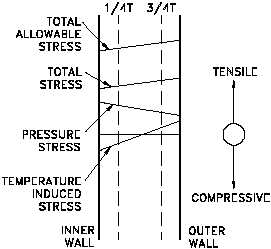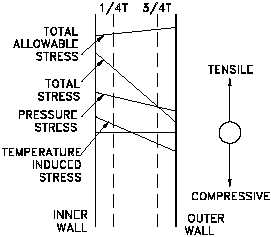Thernal Shock
DOE-HDBK-1017/2-93
PRESSURIZED THERMAL SHOCK
Stresses arising from coolant system pressure
Figure 2 Heatup Stress Profile
exerted against the inside vessel wall (where
neutron fluence is greatest) are always tensile in
nature.
Stresses arising from temperature
gradients across the vessel wall can either be
tensile or compressive. The type of stress is a
function of the wall thickness and reverses from
heatup to cooldown. During system heatup, the
vessel outer wall temperature lags the inner wall
temperature.
The stresses produced by this
temperature gradient and by system pressure will
produce the profile shown in Figure 2.
During heatup, it can be seen that while the
pressure stresses are always tensile, at the 1/4
thickness (1/4 T), the temperature stresses are
compressive. Thus, the stresses at the 1/4 T
location tend to cancel during system heatup. At
the 3/4 T location, however, the stresses from
both temperature and pressure are tensile and thus, reinforce each other during system heatup.
For this reason the 3/4 T location is limiting during system heatup.
During system cooldown, the stress profile of
Figure 3 Cooldown Stress Profile
Figure 3 is obtained. During cooldown, the outer
wall lags the temperature drop of the inner wall
and is at a higher temperature. It can be seen
that during cooldown, the stresses at the 3/4 T
location are tensile due to system pressure and
compressive due to the temperature gradient.
Thus during cooldown, the stresses at the 3/4 T
location tend to cancel. At the 1/4 T location,
however, the pressure and temperature stresses
are both tensile and reinforce each other. Thus,
the 1/4 T location is limiting during system
cooldown.
Plant temperature transients that have the greatest
potential for causing thermal shock include
excessive plant heatup and cooldown, plant
scrams, plant pressure excursions outside of
normal pressure bands, and loss of coolant
accidents (LOCAs). In pressurized water reactors (PWRs), the two transients that can cause the
most severe thermal shock to the reactor pressure vessel are the LOCA with subsequent injection
of emergency core cooling system (ECCS) water and a severe increase in the primary-to-
secondary heat transfer.
Rev. 0
Page 7
MS-03



